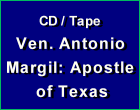Stories & Legends
 |
 |
 |
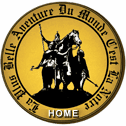 |
 |
 |
 |
Two Battles Won through the
Holy Name of Mary
Two glorious triumphs won under the protection of Our Lady on September 12 have made this day illustrious in the annals of History and won for it the glory of being named the Feast of the Holy Name of Mary.
Simon de Montfort defeats the Albigensians
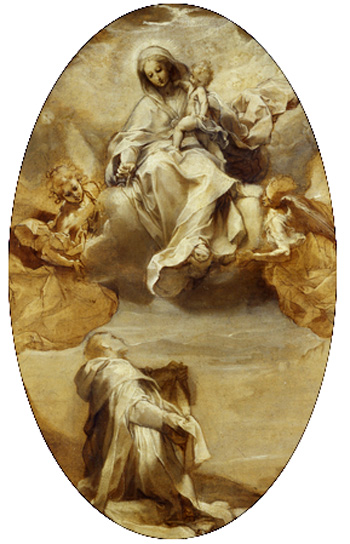 The first victory was in southern France, where the Albigensian or Cathar heresy was spreading its errors. Its poison had even infected feudal lords such as the Counts of Toulose and Foix.
The first victory was in southern France, where the Albigensian or Cathar heresy was spreading its errors. Its poison had even infected feudal lords such as the Counts of Toulose and Foix.
From Heaven Our Lady had appeared to St. Dominic in 1208 to give to him and the world the Rosary as a weapon of defense for the Catholic people. She told him that this would be the most effective weapon against heresy and that it would work many miracles. Dominic took upon himself and his Order the mission to preach against the heresy, fighting relentlessly with the sword of the word and the Rosary.
In France Simon de Montfort – a friend and supporter of St. Dominic – took up the military sword in this fight against the Albigensians. He and his crusader army won a great battle against those heretics on September 12, 1213, at the Battle of Muret.
Count Raymond VI, the Count of Foix and King Peter II of Aragon had set out with a large army to enter the domains of the Count of Montfort, knowing he would counter-attack. Indeed, he did, although his crusader Catholics were outnumbered 40 to 1. Among his small number was St. Dominic, who encouraged the soldiers to pray the Rosary and have confidence in Our Lady.
The Catholic army stopped at Belpech on September 11 because Count Simon de Montfort wished to pray. Entering a church, he knelt and placed his sword and armor before the altar to ask God’s blessing on the coming battle:
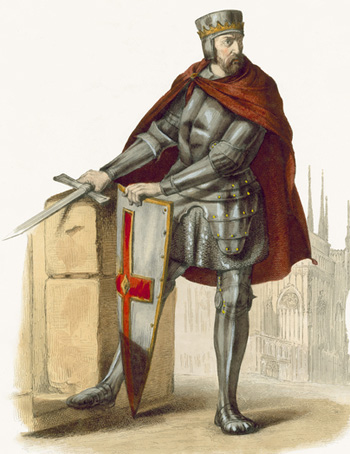 “O Good Lord Jesus, Thou didst choose me, though unworthy I be, to lead Thy battle. This day I offer my weapons before Thy altar so that Thou might bless this battle fought for Thee, and thereby bring a justification of Thy cause.” [2]
“O Good Lord Jesus, Thou didst choose me, though unworthy I be, to lead Thy battle. This day I offer my weapons before Thy altar so that Thou might bless this battle fought for Thee, and thereby bring a justification of Thy cause.” [2]
The next day, on September 12, Simon de Montfort entered battle at Muret. He and his calvary fell upon the heretics at a moment of surprise, and the armies of the threee allies fell into disarray and began to fall back and flee. When the King of Aragon was killed, panic overtook the soldiers. Simon de Montfort and his men advanced and won the day.
This was the last major battle of the Albigensian Crusade and one of the most notable victories of the Middle Ages.
Afterwards, in acknowledgement of the powerful role played by the Rosary in this triumph, Simon de Montfort erected a chapel dedicated to Our Lady of the Rosary in the Church of St. James at Muret. The original bell tower still stands today.
Sobieski wins Vienna
Again, on September 12, Our Lady gave her Catholic warriors a great victory in the year 1683. The Catholic forces led by King Jan Sobieski of Poland were victorious over the Ottoman Turks at the decisive Battle of Vienna. Vienna was a crucial foothold needed to further invade and capture the rest of Europe.
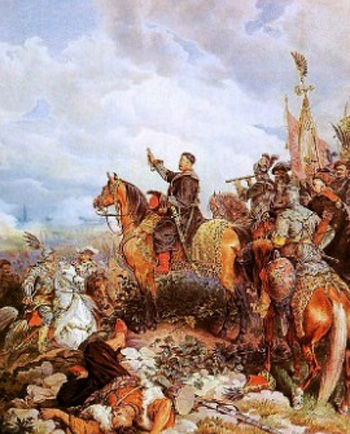 In this battle also the Catholic forces were vastly outnumbered. Over 100,000 Turks of the Ottoman Empire held Vienna under siege, and the Catholics who took back the city numbered only 21,000 men.
In this battle also the Catholic forces were vastly outnumbered. Over 100,000 Turks of the Ottoman Empire held Vienna under siege, and the Catholics who took back the city numbered only 21,000 men.
In the early morning of September 12, 1683, the Catholic armies of Poland, Saxony, Franconia, Swabia, Baden and Bavaria, led by King Jan Sobieski, assisted at Mass. Then the Poles sang an ancient hymn to the Blessed Virgin – a militant and moving song called the Bogurodzica (Mother of God), today considered the national hymn of Poland. The King himself served at the Mass.
Then the “Northern Lion,” as he was called by the Turks, called out to rally the troops: “Let us now march to the enemy with entire confidence in the protection of Heaven, under the assured patronage of the Blessed Virgin.”
Charging upon the enemy camp, they attacked and routed the Muslims. The Turkish forces were overwhelmed and defeated. Vienna was saved under the banner of Mary Most Holy.
In a letter to Pope Innocent XI announcing the victory of the Christian army over the Muslims at the gates of Vienna, King Jan Sobieski attributed the victory to God and not to his own efforts. Paraphrasing the words of Julius Caesar, he wrote: “Veni, vidi, Deus vicit!” (I came, I saw, God conquered!)
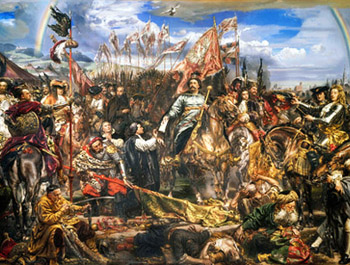 In commemoration of this glorious victory over the Muslims, and in thanksgiving to Our Lady for her protection and assistance in this crucial battle, Pope Innocent XI extended the Feast of the Holy Name of Mary to the Universal Church that same year.
In commemoration of this glorious victory over the Muslims, and in thanksgiving to Our Lady for her protection and assistance in this crucial battle, Pope Innocent XI extended the Feast of the Holy Name of Mary to the Universal Church that same year.
The feast was celebrated on September 15, eight days after Mary’s birth and her name day following the Jewish custom. However, in 1911 Pope St. Pius X decreed that this Feast of Mary be celebrated on September 12 to commemorate the great victory won in Vienna.
Two glorious triumphs, two victories won under the protection of Our Lady, have made this day of September 12 illustrious in the annals of the Church and History. In the first antiphon of the Third Nocturne of the Feast, the Church celebrates: ‘Rejoice O Virgin Mary! Thou alone hast destroyed all heresies throughout the world!”
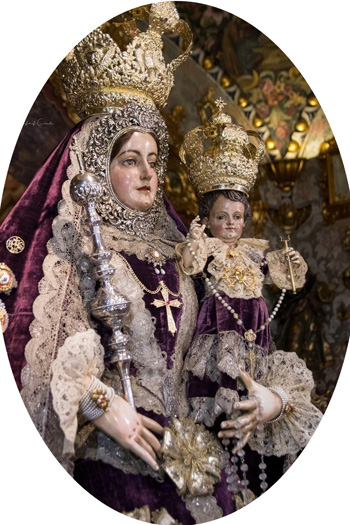
Posted September 13, 2025

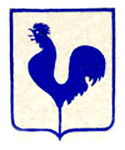
Simon de Montfort defeats the Albigensians

Our Lady gives a new weapon to St. Dominic to defeat heresies - the Rosary
From Heaven Our Lady had appeared to St. Dominic in 1208 to give to him and the world the Rosary as a weapon of defense for the Catholic people. She told him that this would be the most effective weapon against heresy and that it would work many miracles. Dominic took upon himself and his Order the mission to preach against the heresy, fighting relentlessly with the sword of the word and the Rosary.
In France Simon de Montfort – a friend and supporter of St. Dominic – took up the military sword in this fight against the Albigensians. He and his crusader army won a great battle against those heretics on September 12, 1213, at the Battle of Muret.
Count Raymond VI, the Count of Foix and King Peter II of Aragon had set out with a large army to enter the domains of the Count of Montfort, knowing he would counter-attack. Indeed, he did, although his crusader Catholics were outnumbered 40 to 1. Among his small number was St. Dominic, who encouraged the soldiers to pray the Rosary and have confidence in Our Lady.
The Catholic army stopped at Belpech on September 11 because Count Simon de Montfort wished to pray. Entering a church, he knelt and placed his sword and armor before the altar to ask God’s blessing on the coming battle:

Count Simon de Montfort presents his weapons at the altar to receive God’s blessing for battle
The next day, on September 12, Simon de Montfort entered battle at Muret. He and his calvary fell upon the heretics at a moment of surprise, and the armies of the threee allies fell into disarray and began to fall back and flee. When the King of Aragon was killed, panic overtook the soldiers. Simon de Montfort and his men advanced and won the day.
This was the last major battle of the Albigensian Crusade and one of the most notable victories of the Middle Ages.
Afterwards, in acknowledgement of the powerful role played by the Rosary in this triumph, Simon de Montfort erected a chapel dedicated to Our Lady of the Rosary in the Church of St. James at Muret. The original bell tower still stands today.
Sobieski wins Vienna
Again, on September 12, Our Lady gave her Catholic warriors a great victory in the year 1683. The Catholic forces led by King Jan Sobieski of Poland were victorious over the Ottoman Turks at the decisive Battle of Vienna. Vienna was a crucial foothold needed to further invade and capture the rest of Europe.

King Jan Sobieski during the Battle of Vienna
In the early morning of September 12, 1683, the Catholic armies of Poland, Saxony, Franconia, Swabia, Baden and Bavaria, led by King Jan Sobieski, assisted at Mass. Then the Poles sang an ancient hymn to the Blessed Virgin – a militant and moving song called the Bogurodzica (Mother of God), today considered the national hymn of Poland. The King himself served at the Mass.
Then the “Northern Lion,” as he was called by the Turks, called out to rally the troops: “Let us now march to the enemy with entire confidence in the protection of Heaven, under the assured patronage of the Blessed Virgin.”
Charging upon the enemy camp, they attacked and routed the Muslims. The Turkish forces were overwhelmed and defeated. Vienna was saved under the banner of Mary Most Holy.
In a letter to Pope Innocent XI announcing the victory of the Christian army over the Muslims at the gates of Vienna, King Jan Sobieski attributed the victory to God and not to his own efforts. Paraphrasing the words of Julius Caesar, he wrote: “Veni, vidi, Deus vicit!” (I came, I saw, God conquered!)

Jan Sobieski sends a message
to Innocent XI after the victory
The feast was celebrated on September 15, eight days after Mary’s birth and her name day following the Jewish custom. However, in 1911 Pope St. Pius X decreed that this Feast of Mary be celebrated on September 12 to commemorate the great victory won in Vienna.
Two glorious triumphs, two victories won under the protection of Our Lady, have made this day of September 12 illustrious in the annals of the Church and History. In the first antiphon of the Third Nocturne of the Feast, the Church celebrates: ‘Rejoice O Virgin Mary! Thou alone hast destroyed all heresies throughout the world!”

The weapon Our Lady gave for victory
Posted September 13, 2025







